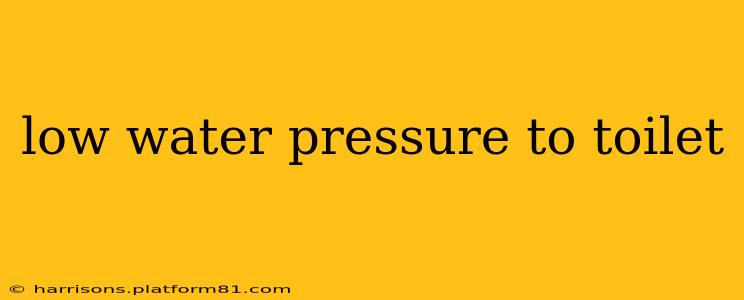Low water pressure in your toilet is a frustrating problem, leading to weak flushes and potential clogging. This comprehensive guide will help you diagnose the issue and find effective solutions. We'll cover common causes, troubleshooting steps, and preventative measures to ensure your toilet consistently performs optimally.
Why is My Toilet's Water Pressure Low?
Several factors can contribute to low water pressure specifically affecting your toilet. It's crucial to differentiate between low pressure affecting only the toilet and low pressure throughout your entire house. If the entire house has low pressure, the problem lies with your main water supply, requiring professional intervention. However, if only your toilet is affected, the issues are usually more localized and often solvable with DIY methods.
1. Clogged Toilet Fill Valve
The fill valve is responsible for refilling the toilet tank after each flush. A clogged fill valve restricts water flow, resulting in a weak flush. Debris like mineral deposits, sediment, or even small objects can accumulate and impede its function.
Solution: Turn off the water supply to the toilet. Remove the tank lid and inspect the fill valve. Carefully remove any visible debris. If the valve is severely clogged or damaged, replacement is often the most effective solution. These are readily available at most hardware stores.
2. Restricted Water Supply Lines
The water supply lines connecting your toilet to the main water supply can become restricted due to mineral buildup, corrosion, or kinks. This reduces the amount of water reaching the tank.
Solution: Check the supply lines for any visible damage, kinks, or buildup. If you identify a kink, try gently straightening it. For mineral deposits or corrosion, you might need to replace the supply lines entirely. This is a relatively straightforward plumbing task, but if uncomfortable, it's best to call a plumber.
3. Low Water Pressure in the Entire House (But Affecting the Toilet Most Noticeably)
While low pressure in your entire home isn't directly a toilet problem, it can manifest as particularly weak toilet flushes because toilets require significant water volume for effective flushing. The reduced overall pressure can exacerbate existing minor problems in the toilet's plumbing, leading to the noticeable issue.
Solution: If this is the case, you need to investigate the main water supply to your home. This may involve checking the water meter for low readings, looking for leaks within the house's plumbing, or even contacting your local water utility to rule out a pressure issue originating from their system. This is often a task for a professional plumber.
4. Faulty Flapper Valve
The flapper valve at the bottom of the tank controls water release into the bowl. If it's not sealing properly, water might continuously leak into the bowl, reducing the amount available for flushing.
Solution: Inspect the flapper valve for wear and tear or damage. If it's worn, cracked, or doesn't seal completely, replace it. These are inexpensive and easy to install.
5. Incorrect Toilet Tank Level
The water level in the toilet tank should be at the designated fill line. If the water level is too low, the flush will be weaker. This can be due to a misadjusted fill valve or a problem with the tank's float.
Solution: Check the water level in the tank. If it's below the fill line, adjust the fill valve accordingly. If the float is damaged or not functioning correctly, it may need to be repaired or replaced.
How Can I Improve My Toilet's Water Pressure?
Beyond addressing the root cause, some strategies can improve your toilet's overall performance:
- Regular Maintenance: Clean your toilet tank and regularly check for mineral buildup or debris. This preventative maintenance can prevent many issues before they become major problems.
- Professional Inspection: If you've tried troubleshooting and still have low water pressure, call a qualified plumber. They can identify hidden issues and provide expert solutions.
By systematically addressing these potential problems, you can effectively resolve low water pressure issues in your toilet and restore its optimal flushing performance. Remember safety first – turn off the water supply before undertaking any repairs.
